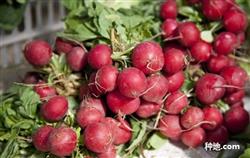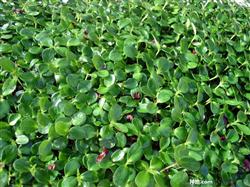How to cultivate mini radish?

How to cultivate mini radish? Mini radish is a kind of small radish with short growth period and rapid growth of fleshy roots. the growth period of each crop is less than 1 month, the root skin is dark red, the color is beautiful, it can be eaten raw, fried or pickled, and its flavor is unique. It is a high-quality pollution-free vegetable and is deeply welcomed by consumers. The cultivation techniques are introduced as follows: first, the variety selection of mini radish varieties that have not been popularized on a large scale in China at present, and the imported varieties are mainly Japanese "20-day big root" and "40-day big root". Among them, the cultivation of "20-day big root" is more common. The fleshy roots of these two varieties are round, 2cm in diameter, 1520g in weight (10g / 12g in commercial maturity), red in root skin, white in meat, 20cm in plant height, adaptable and not heat-resistant. It is suitable for cultivation in open field in early spring and autumn and in winter. The main differences between the two are as follows: the former prefers mild climate with a growth period of 20-25 days, while the latter has a strong cold resistance with a growth period of 30-35 days. Taking "20 days big root" as an example, this paper briefly introduces the main points of its cultivation techniques. Second, the soil requires that the fleshy root of mini radish is small and the growing period is short. Sandy loam with loose texture and good drainage and irrigation should be selected. The thickness of soil layer is not strict, and the depth is more than 20 cm. There can be no debris such as stones and rubble in the soil to avoid bifurcation and other deformities of fleshy roots. It is not suitable to choose the cooked vegetable field which has been planted for many years, because the topsoil is more fertile and the nitrogen is generally on the high side, it is easy to cause the leaves to flourish and grow, resulting in nutritional imbalance and multiple whisker roots, thus affecting the normal expansion of the roots. In addition, the residual pathogens in cooked vegetable land have a large number of pests and are prone to diseases and insect pests. Third, the soil preparation of mini radish is cultivated in suitable soil, so that the fleshy root can have enlarged rhizome, correct shape, smooth skin, beautiful color and good quality. Therefore, soil preparation requires deep ploughing and drying, leveling and meticulous, and uniform fertilization in order to promote the increase of effective nutrients and beneficial microorganisms in the soil, and can store water and preserve fertilizer, which is conducive to the absorption of nutrients and water by roots. Fertilization based on base fertilizer, generally do not need topdressing, can be one-time application of organic fertilizer and compound fertilizer, generally 667 square meters (1 mu) about 2000 kg of rotten barnyard manure as base fertilizer. If fertilization is uneven, it is easy to cause local fertilizer damage. After land preparation, it is made into a flat bed, with a width of 1 to 1.2 meters, whichever is convenient for field management. Fourth, sowing in the open field, spring is generally from mid-late March to late April, autumn is from early August to early October, and greenhouse cultivation can be arranged from mid-October to early March. When the air temperature was low in deep winter, the barbecue was closed 7-10 days before sowing, and the soil temperature in the greenhouse was more than 5 ℃. Due to high temperature and rain in summer, the quality of fleshy root is poor, so it is not suitable to be planted. In order to facilitate timely postharvest processing, it is appropriate to stagger the sowing date in batches. The bottom water was poured 3-4 days before sowing, the water was evenly seeped, and when the topsoil was slightly dry, the ground was sown. The row spacing is 15 cm, the plant spacing is 3 cm, the sowing depth is 1.5 cm ~ 2 cm, and the sowing amount is 1000 ~ 1200 grams per square meter. Fifth, field management mini radish growth period is short, field management is relatively simple. If there is a rainy day before seedling emergence in open field cultivation, the soil may be hardened, so the soil should be loosened in time to make the germinated seeds unearthed smoothly. Less watering at seedling stage is beneficial to restrain shoot overgrowth. It takes about 15 days from the belly to the fleshy root to form, during which the soil should be kept moist, but not too dry. Watering should be uniform, and the soil water content should be 70% to 80%. If the water is insufficient, it will increase the fibrous root of the fleshy root, resulting in rough outer skin, thick spicy taste, bran heart and so on. Winter protected cultivation should pay attention to heat preservation and cold protection, keeping 15: 20 ℃ during the day and 8: 10 ℃ at night, not less than 5 ℃ after emergence. During the period of fleshy root expansion, the greenhouse temperature was maintained at 13-18 ℃ after the belly-breaking of seedlings. Fertilizer may not be applied during the growth period, and if the plant is too short or the leaves turn yellow, a small amount of available nitrogen fertilizer can be applied with watering and 0.3% potassium dihydrogen phosphate solution can be sprayed. Timely ploughing and weeding is beneficial to keep the soil loose, prevent topsoil from hardening and promote the normal expansion of fleshy roots. 6. Prevention and control of major diseases and insect pests. Sudden collapse disease: it is easy to occur in the seedling stage of repeated cropping plots, and it usually occurs within 5-6 days after emergence. Simple control method: the kimchi water used in farm processing kimchi and sauerkraut was mixed with a small amount of active milk, diluted with water at the ratio of 1 ∶ 4 to 5, and sprayed once every 2 to 3 days. The use of lactic acid bacteria can effectively inhibit the occurrence of the disease. two。 Black spot: fungal disease. Before the onset of the disease, use 75% chlorothalonil 500 times 600 times liquid or 50% Shu Ke Ling powder 1500 times liquid, once every 5 to 7 days. At the initial stage of the disease, 50% carbendazim 800 times solution was sprayed once a week. 3. Aphids, cabbage insects: easy to occur when high temperature and drought, pay attention to timely drought-resistant watering, the initial stage of insect pests with 2.5% deltamethrin 2000-2500 times liquid spray control. 7. Mini radish can be harvested after growing for 20 days in spring and autumn and 28 days in cold season in winter. The fleshy root should be harvested in time when the diameter of the fleshy root is more than 2 cm and the single ball weighs 10 to 12 grams. Early harvest affects the yield, too late, the amount of fleshy root fiber increases, which is easy to produce split root and bran heart, which affects the product quality. Water the soil before harvest to make the soil soft and moist. When harvesting, the stems and leaves can be pulled up together with the fleshy root. After harvest, the fleshy root with bright color and symmetrical shape is selected and washed with leaves, which can be sold on the market, and the general commodity output can reach 1 kg / square meter. Click for more radish planting techniques click to get more vegetable planting techniques
- Prev

What causes the hollowness of radish
How to grow turnips in autumn? Please introduce that green radish can be planted as follows: first, sow seeds. Sow seeds in late July and use 0.5 kg per mu. Ditch strip sowing on the ridge, sowing depth 3 cm, covering fine soil 2 cm thick, trampling after sowing. Second, seedling management. Keep the soil moist before emergence. On the seedlings 1 true leaf and 3.
- Next

How can radish increase production?
How to plant radish buds to produce high yield? Please point out radish bud, is formed by radish seed germination fat tender seedlings, its hypocotyls 6~8 cm long, cotyledons plump taste spicy, nutritious. Seed selection should be full of seeds, such as big green radish, red heart, full garden flower seeds, green manure radish, etc.; requirements for seed selection
Related
- Where is it suitable to grow horseradish in China? it is expected to see the middle altitude horseradish in Alishan.
- How to prevent tomato virus disease reasonably? (Control methods included)
- Many people like to plant towel gourd on the balcony. What are the main points of this method and management?
- What crops can chili peppers be mixed with?
- Fertilization techniques and matters needing attention in Tomato
- What are the grafting techniques for peach seedlings in spring?
- Harm and control methods of root swelling disease of Chinese cabbage
- What are the pests of sweet potatoes? How to prevent and cure it?
- Symptoms, causes and Control methods of navel Rot in Tomato
- The cause of "Cucumber rotten bibcock" in Farmers' planting Cucumber and its Control Plan

